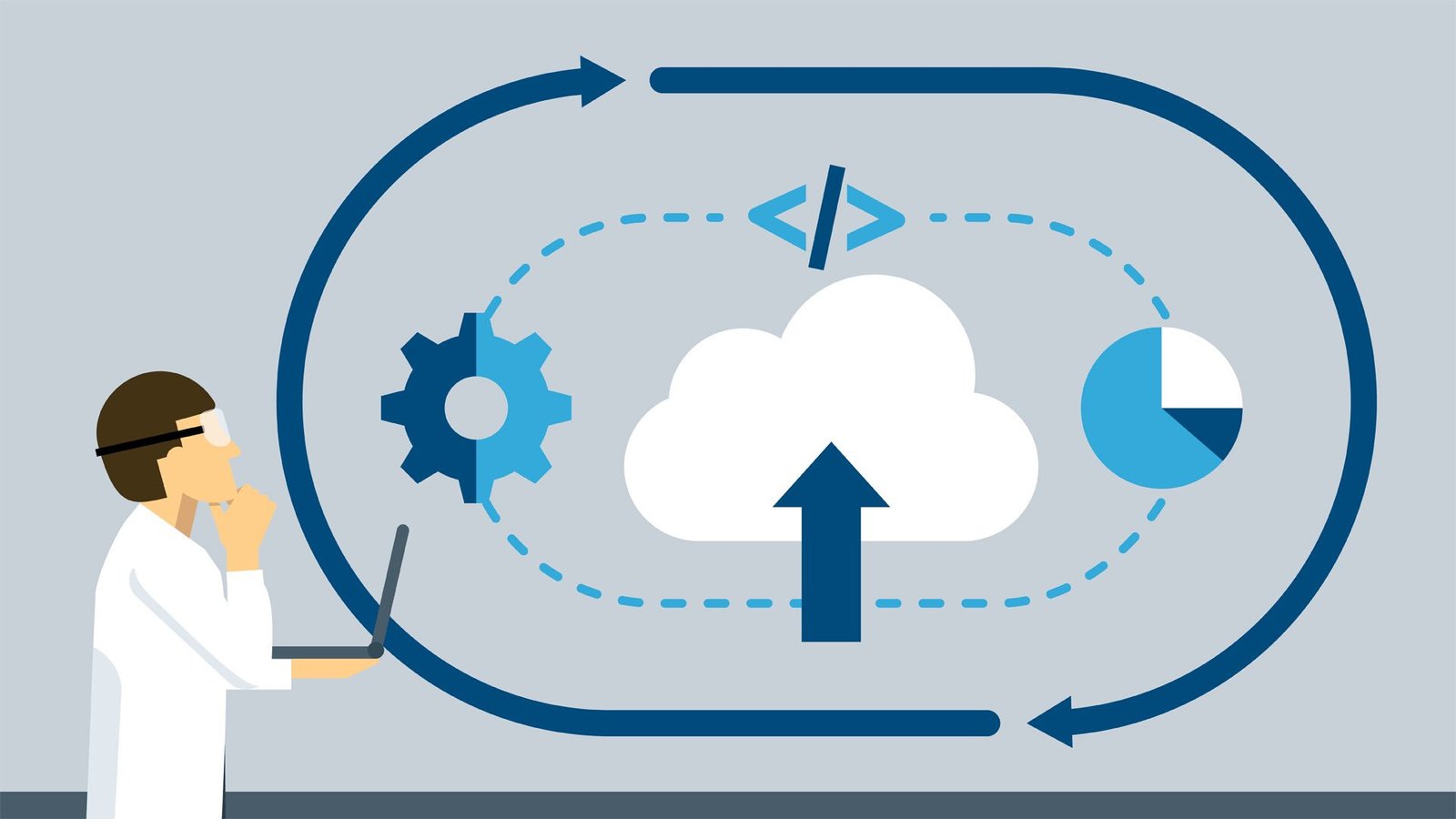Technology
Unleashing Agility and Efficiency: Exploring the Synergy between Cloud and DevOps

Now these days we are moving to the digital landscape Many firms or organizations facing pressure for delivering software applications faster, more reliably, and at a lower cost. To meet these demands, businesses are turning to two powerful technological forces: the cloud and DevOps. The combination of cloud services and DevOps practices has emerged as a winning formula for achieving agility, efficiency, and innovation in software development and deployment.
Cloud Service Solutions: Empowering Scalability and Flexibility
Organizations can take advantage of the benefits of virtualization, on-demand resource provisioning, and pay-as-you-go pricing structures by using cloud service solutions.
There are many benefits of this cloud services but the important is scalability.
Furthermore, cloud services offer unmatched flexibility. Developers can spin up and tear down environments and resources on-demand, enabling rapid experimentation and iteration. This flexibility accelerates the development and testing process, allowing organizations to deliver new features and updates to customers at an unprecedented pace.
DevOps Consulting Services: Bridging the Gap between Development and Operations
DevOps, a set of practices that combines software development (Dev) and IT operations (Ops), has gained immense popularity in recent years. DevOps aims to break down silos, foster collaboration, and automate the software delivery process, ultimately enhancing agility and quality.
DevOps consulting services play a crucial role in guiding organizations through the adoption of DevOps principles and practices. By leveraging their expertise and experience, DevOps consultants help organizations streamline workflows, implement automation tools, and establish a culture of continuous integration and delivery (CI/CD). They also facilitate the adoption of modern software development methodologies such as Agile and Lean, which align perfectly with DevOps principles.
The Synergy: Cloud and DevOps in Harmony
The convergence of cloud services and DevOps is a natural fit. Cloud computing provides the infrastructure and tools necessary for implementing DevOps practices effectively. Here’s how the synergy between the two can be harnessed to unlock agility and efficiency:
- Rapid Provisioning: Cloud services allow teams to provision development, testing, and production environments quickly. DevOps practices leverage this capability to automate the deployment process, ensuring consistency and reducing the risk of errors caused by manual interventions.
- Scalable Infrastructure: The cloud’s elastic nature enables DevOps teams to scale infrastructure resources up or down based on demand. This scalability is essential for handling sudden spikes in user traffic, ensuring smooth application performance, and optimizing costs.
- Collaboration and Communication: DevOps emphasizes collaboration between development, operations, and other stakeholders. Cloud services provide a unified platform for teams to work together seamlessly, sharing code, configurations, and monitoring data. This enhances communication, reduces friction, and promotes a culture of shared responsibility.
- Continuous Integration and Delivery: Cloud-based CI/CD pipelines enable organizations to automate the build, test, and deployment processes. By integrating with cloud service solutions, DevOps teams can easily trigger automated tests, manage code repositories, and deploy applications to various environments, significantly reducing the time to market.
- Cloud platforms offer sophisticated monitoring and analytics capabilities, giving users access to real-time data on user activity, resource usage, and application performance. DevOps teams can leverage these insights to identify and resolve issues proactively, optimize resource allocation, and make data-driven decisions.
The combined power of cloud services and DevOps consulting services drives innovation, accelerates time-to-market
n conclusion, the synergy between cloud computing and DevOps has unleashed remarkable agility and efficiency in the world of software development and deployment. By integrating cloud services with DevOps practices, organizations have been able to accelerate their software development lifecycle, enhance collaboration, and achieve higher levels of automation and scalability.
Cloud computing provides a flexible and scalable infrastructure that enables DevOps teams to rapidly provision resources, easily scale up or down, and leverage a wide range of services for application development, testing, and deployment. This elasticity eliminates the need for upfront infrastructure investments and allows organizations to respond quickly to changing market demands.
DevOps, on the other hand, emphasizes collaboration, communication, and automation among development, operations, and quality assurance teams. By breaking down traditional silos and promoting cross-functional collaboration, DevOps fosters a culture of continuous integration, continuous delivery, and continuous improvement. This approach enables organizations to deliver software more frequently, with higher quality, and with reduced time-to-market.
AI Trends
Empowering Your Digital Strategy With Chatbots

Social media has spoiled us and shrunk our attention span drastically in the past couple of decades. While attention spans continue to shrink, customer expectations continue to rise and that’s why you need a way to instantly respond to your customers whenever and wherever they want.
That’s where chatbots come in. They don’t just make your digital presence stronger, but open new sales avenues and marketing opportunities. White-label digital marketing companies can help you finetune those marketing and integration strategies for better growth.
Before we proceed to strategies, let’s check out how chatbots can help your digital marketing strategies:
- Lead generation- Your site attracts all kinds of traffic. Chatbots can initiate conversations with them and generate valuable leads that can be further filtered out with more targeted questions. So, the pre-sales team can be smaller.
- Always available- When you outsource your digital marketing needs to a white label SEO agency in India, they can target the right keywords to draw in the right global audience to your site. Chatbots can stay on 24/7 to solve problems and answer questions of those people irrespective of the time zone difference.
- Drive sales- Chatbots can provide personalized recommendations to users. Depending on their purchase history, browsing pattern, and other such data, chatbots can recommend personalized discounts for relevant products and increase sales.
- Flawless customer support- Chatbots were originally designed to smoothen customer support and do it flawlessly by helping your customer troubleshoot basic problems and answering FAQs.
Tips to integrate chatbots into your digital marketing strategy:
1. Set your goals
All purpose chatbots aren’t impossible, but require more resources and can be quite expensive. They are usually AI-powered and the price you end up paying can vary drastically depending on the number of customers who access that chatbot. According to white label digital marketing agencies in India, small businesses are better off focusing their limited resources on goal-oriented chatbots.
When you choose a goal like lead generation, cross-selling, or simply answering FAQs, you’ll have a clear direction for funneling your resources. For instance, if you’re a small bakery that is looking to solve customer queries online and familiarize them with your establishment, an FAQ-focused chatbot is perfect, cheap, and all you need.
2. Improve User Experience
According to search engine optimization companies for small businesses, user experience, sales, and search engine ranking are all integrated and chatbots are the ultimate solution to improve user experience. For instance, an AI chatbot can help you improve customer experience drastically.
AI can understand your customer queries better and provide them with tailored solutions readily to address their problem. This makes customers dwell longer on your page and sends all kinds of signals to search engine algorithms. Moreover, the user interactions gathered by the chatbot can be used by offshore marketing agencies to optimize website content and give more useful information to your users.
If you are a small business, AI chatbots may be out of your budget. In that case, raft questions thoughtfully to create a natural conversation flow. Think from the customer’s perspective and provide concrete answers and options to choose from. It’s also important to leave the option for chatting with a live customer support representative when the customer doesn’t get satisfactory answers.
3. Connect with social media accounts
Modern chatbot platforms bring the revolutionary option of integrating social media chatbots to your site and all other channels. Why is this revolutionary for marketing? When clients send a query on WhatsApp, Facebook, LinkedIn, or on your site, you access and reply to them from a single dashboard.
While your customers stay happy with answered queries, you get to automate marketing campaigns and run promotions and contests on all channels with a single click. Convenient, powerful, and revolutionary indeed. You also have the option to track individual customer interaction on every channel and push personalized communication.
It’s ironic when social media is responsible for reducing our attention spans and social media chatbots help companies to interact more with their customers and win back their attention. Either way, as long as you have the help of a white-label digital marketing agency that curates your chatbot integration strategy, you can hit all the goals of increased sales, leads, and customer satisfaction.
Technology
How to Choose the Right VPS Hosting in Germany for Forex Trading

Introduction
Choosing the right VPS Hosting in Germany for forex trading is essential for traders seeking reliable and low-latency connections to the global market. In the strategic location of Germany where major financial hubs and big firms are situated, choosing the best VPS provider is essential for your business growth. When selecting a web hosting provider for the best VPS hosting in Germany, you must prioritize factors such as network, stability, latency, server location, etc. In this article, we will discuss how you can choose a cheap VPS hosting Plan by providers in Germany for forex trading and its uses. Let’s dive into the world of information and find some useful information about forex trading.
Define What is VPS Hosting for Forex
VPS server in Germany for forex means virtual private server hosting, that provides traders with a virtual environment to run their trading platforms and strategies 24/7. For forex trading, VPS Hosting offers greater control and dedicated resources over server settings, ensuring consistent performance even during peak trading hours.
In the context of forex trading, VPS hosting is crucial for maintaining stable connections and accommodating the demand for forex trading software.
Why Do Traders Need Forex VPS Hosting in Germany?
In the forex VPS server in Germany every second matters. A little delay of a few seconds can cause significant losses. Forex VPS hosting minimises latency, which helps you execute trades with precision. It doesn’t matter whether you are a day trader or a scalper, reduced latency can be the key to profitable trading.
1. The forex trading market is rife with cyber threats, A VPS hosting in Germany offers a secure environment, that protects your data and strategies from being stolen or security breaches.
2. Unforeseen technical issues can disrupt your trading operations. With Forex VPS Hosting you can enjoy higher uptime, which ensures that your trade isn’t compromised.
3. If you use resource-intensive trading strategies, such as algorithmic or high-frequency trading, a Germany VPS server is required for peak performance.
Choosing The Right Hosting Provider for Forex VPS Server in Germany
Selecting the right VPS hosting provider in Germany for forex trading is a crucial decision. Here is a step-by-step guide to help you make a wise choice.
1. Server Location and Latency:
Opt for a VPS Germany provider with a service location close to your broker’s data center. Sever location plays a crucial role in fores it reduces the latency and does faster order execution. Lower latency is the key factor in achieving better trade outcomes.
2. Security Measures:
You need to check web hosting provider security measures if they provide advanced security for your server such as firewall, encryption, and DDoS-protected VPS. Robust Security Measures are must-have things to safeguard your trading data and strategies.
3. Scalabilities Options:
A flexible and scalable hosting solution is essential for adapting to the dynamic nature of forex trading. You need to choose a provider that offers scalability options, allowing you to easily upgrade or downgrade your fast Germany VPS.
4. Assessing the Resources:
Assessing the allocated resources is crucial for ensuring the higher optimal performance for forex trading activities. Choose the VPS hosting in Germany provider who offers sufficient resources to fulfill the demand of running multiple trading platforms and executing complex trading strategies.
5. Backup Recovery:
Losing data can be very harmful for a trader. Choose a web hosting provider that offers regular backups and disaster recovery plans. Data protection is essential which ensuers you about your data recovery in the unexpected times.
Need of Hostbillo’s best VPS Hosting for the Forex Trading
Hostbillo’s cheap VPS server in Germany is a valuable asset for forex traders who are seeking reliable and cost-effective solutions to optimize their trading operations. Hostbillo Hosting Solution is the best web hosting provider in Germany, known for providing exceptional service to businesses.
Hostbillo offers strategic server locations with its Germany VPS Server to ensure optimal performance and reduce latency. With Hostbillo’s Cheap VPS hosting in Germany, you get high performance, top security, and higher uptime with 24/7 customer support.
Moreover, Hostbillo’s affordable pricing plans make it accessible to traders of all levels, allowing them to leverage the benefits of VPS hosting in Germany without thinking about expenses. Hostbillo Cheap VPS Hosting empowers forex traders to focus on their strategies and capitalize on marketing opportunities with confidence and efficiency.
Conclusion
In Conclusion, Forex VPS Hosting is a powerful web hosting that can improve your trading performance. It offers reduced latency, higher performance, enhanced security, and improved uptime which are crucial features for success in the forex market. By carefully choosing the right server provider you can ensure to get a competitive edge in the world of Forex trading. Explore the world of VPS hosting for forex today and rest assured about your trading business. You can also choose Hostbillo Hosting Solutions for the best Forex VPS Server in Germany.
Read more:
Empowering Small Businesses With Their Debut Webinar
Counter.wmail-service.com:A detailed Guide about this Trojan
Technology
How Do You Develop an Admin Panel for the Delivery Everything App?

To understand what an administration panel is in a Delivery Everything App, you have to imagine an interface at allows you to manage the content of the said platform. Let’s understand this in a much more detailed manner.
Introduction
The admin panel is built into a custom development based on the characteristics of the app. Things like managing a server and taking care of registrations and payments, coupled with reviews and other issues, are managed by this panel. Overall, it offers administrators a space to make modifications as per the feedback of the customer.
What is an administration panel in a Delivery Everything App?
Administration panels are also known as administrator applications or control panels and can occur in any technological development, both web and mobile. Through them, those responsible for the site can modify some of the app’s content. You can even create user levels and permissions to limit the actions that each user can take within the application. In the case of a Delivery Everything App, the administration panels are usually somewhat similar, saving some important differences.
What content does an admin panel manage?
In the administration panel of a Delivery Everything App, new modules or new functionalities of the app cannot be built. That is done in the development stage. However, many elements can be modified or viewed, like assessing the server and building the app under heavy load. Others also include:
Push Notifications
One of the attractions of mobile applications is push notifications, which are ideal and customizable elements to strengthen memory and the relationship with the user. From the control panel of an app, it is possible to select the content that will appear in the notifications, the user segmentation, and when they will be sent. In addition, notifications that were not planned at the time of app development can be scheduled, for example, for special actions such as marketing campaigns.
Chat
If it is a real-time chat between an administrator and users, a control panel is necessary that collects all messages. A space that centralizes information and from which control of customer requests can be established. Responses are also managed through it to offer an efficient and fast messaging service. In the case of having a chatbot, the use of an administration panel would not be necessary since the responses are made automatically and programmed.
Content update
As we indicated previously, administration panels are very useful for businesses whose products or services are constantly changing.
Let’s imagine an online delivery app that shows the plans and offers that can be made when ordering food, for example, offers in restaurants, plays, and promotions in a leisure place. The logical thing is that these offers change day by day because there are new offers that appear and others that expire on a certain date. A platform where a series of administrators are in charge of publishing new content and eliminating expired content.
They can also be quite useful for applications whose products change frequently. However, for this type of business, it is best to connect the app to automate all possible processes.
Control of registered users
An administration panel is very functional when it comes to mobile applications that require control over the registration of end users. In them, it is not the user who registers in the app but is registered by the person in charge. This is usually the case with mobile applications aimed at a limited and reduced number of users. Through the app’s administration panel, an administrator will be in charge of registering new users and assigning permissions to each of them.
Metrics and statistics
In the control panel, you can record the activities carried out in the app with relevant data for subsequent reports. The visualization of metrics is essential for fields such as marketing, sales, or customer service since they allow a very detailed analysis of the results.
It is possible to access a general summary of the configured metrics. Analyzing aspects such as the number of downloads, logins, transaction history, demographic data, or even the mostly clicked buttons. Thanks to these metrics, you will know the performance of the app’s screens and whether the integrated functionalities are successful.
Control of content
If partners are in charge of uploading the app’s content, an administration panel can be very useful in detecting inappropriate posts and easily eliminating them. A concrete example could be delivery requests, where those in charge of feeding the content of the app are its drivers. With the help of an administration panel, you can delete or block inappropriate content.
User Management
One of the main contexts where an app administration panel serves to control users is in applications for meeting other people or finding a driver.
Those who are registered have the possibility of reporting users who do not comply with the platform’s rules or who behave inappropriately. Thanks to the administration panel, the company can collect the complaints sent and take the measures it deems appropriate, such as eliminating the user in question.
What’s Next?
Successful app-based delivery companies employ dedicated developers to use PHP programming languages for the creation of robust admin panels. If you are not planning to reach such heights of hiring and planning, simply go to a white-label firm and buy a ready-made admin panel made specifically for a Delivery Everything App solution.
Moreover, such professional white-label firms offer admin panels in packages to help budding entrepreneurs save costs by skipping the design and development phases entirely. All you have to do is make sure that the demo is up to the mark and that the firm is over a decade old in experience and delivery.
Conclusion
Developing a Delivery Everything App is an important investment, there is no doubt, which is why it is convenient to have absolute control of everything that happens in them. The administration panels provide that absolute knowledge since, from them, you can monitor all the activity of the app, accounting for the KPIs, and they allow you to update its content constantly.
Read more:
-

 Development12 months ago
Development12 months agoHow Blockchain Is Driving A Revolution In The Gaming Industry
-

 Business9 months ago
Business9 months agoWhy Are Custom Tuck Boxes Trending In Retail Product Market
-

 Entertainment7 months ago
Entertainment7 months agoWhat Does the Moon Mean on Instagram? A Complete Guide to Quiet Mode
-

 Entertainment6 months ago
Entertainment6 months agoSwatchSeries: An All-Inclusive Guide for Fans of TV Series and Films
-

 Entertainment7 months ago
Entertainment7 months agoWcofun.net: One Stop Shop for All Cartoon and Anime Content
-

 Entertainment7 months ago
Entertainment7 months agoWCOFUN.TV for Children: An Aid for Parents!
-

 Entertainment7 months ago
Entertainment7 months agoWCOFUN: Watch Free Cartoons and Anime
-

 Services6 months ago
Services6 months agoHow Carpet Cleaning Services Keeps Carpets Looking New





















